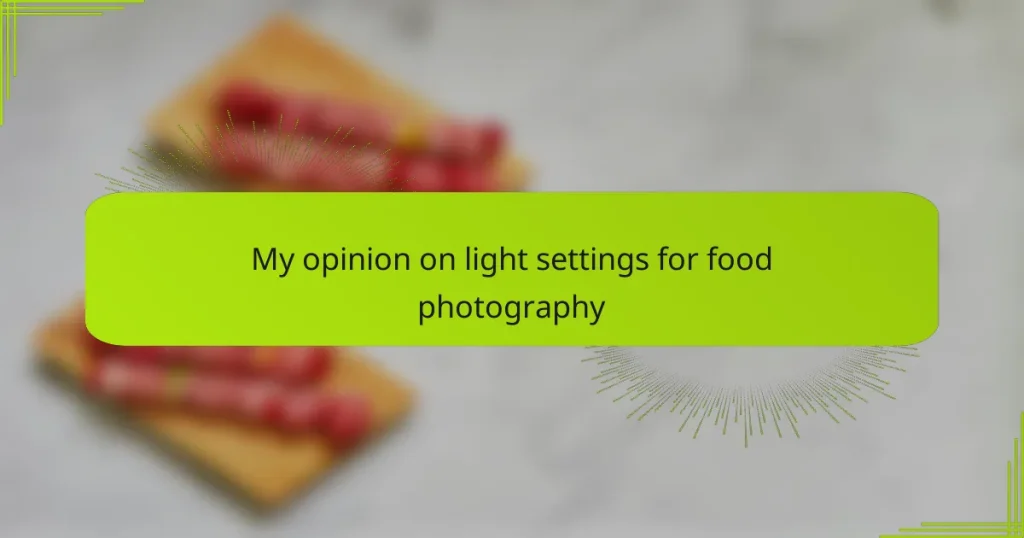Key takeaways
- Experimenting with light angles and intensity can significantly enhance the mood, texture, and appeal of dessert photos.
- Soft, diffused lighting is preferred, as it highlights details without overwhelming the subject, while avoiding harsh shadows and direct light.
- Color temperature plays a crucial role; warm light can evoke comfort, while cooler light offers a fresh vibe.
- Using reflectors and adjusting light sources can eliminate unwanted shadows and enhance the dessert’s visual appeal.
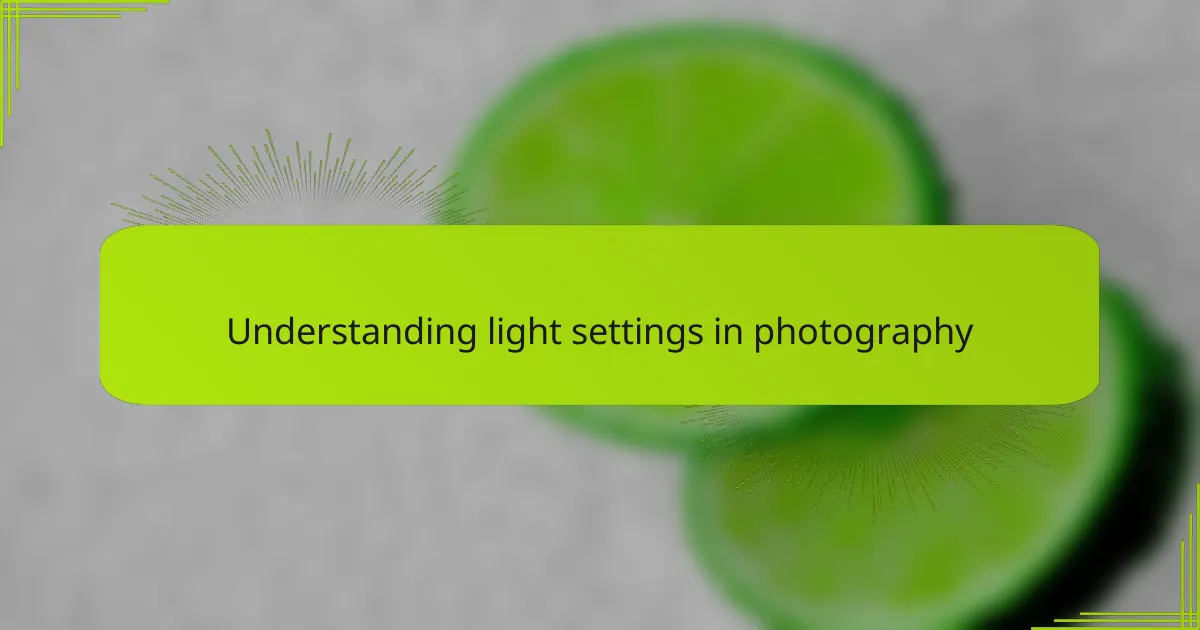
Understanding light settings in photography
Light settings in photography can feel like a secret code at first, but once you start experimenting, it becomes a language that tells your food story. Have you noticed how changing the angle or intensity of light can transform a simple dessert into something mouthwatering? I remember when I first played with natural window light – suddenly, my photos felt alive, inviting you to almost taste the sweetness.
Controlling light isn’t just about brightness; it’s about mood and texture. Soft, diffused light can make a creamy cake look ethereal, while harsher shadows might highlight the crisp edges of a tart. These choices felt so subtle to me initially, yet they’ve become the tools I rely on to express the delicious details that make desserts irresistible.
What really blew me away was how much the color temperature matters. Warm light can make a chocolate mousse feel cozy and indulgent, whereas cooler light might evoke a fresh, clean vibe for fruit tarts. Understanding these nuances isn’t just technical—it’s personal. It’s about capturing the feeling you want to share with anyone who sees the photo.
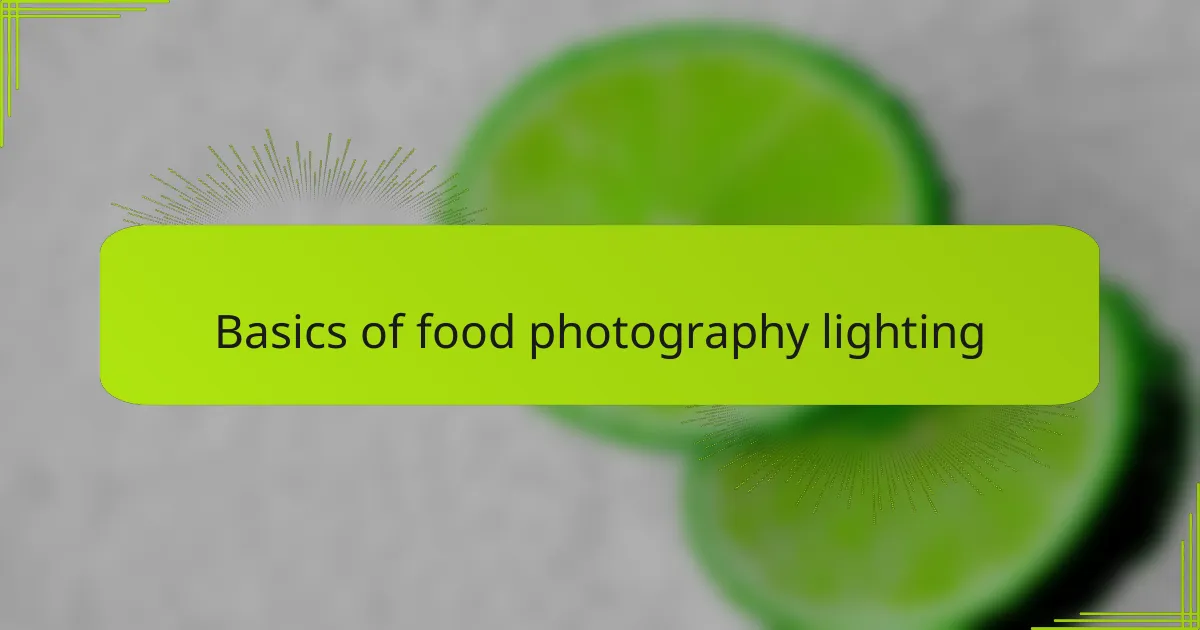
Basics of food photography lighting
Lighting in food photography starts with recognizing the source. Do you prefer natural light streaming through a window or the controlled glow of artificial lamps? I’ve found that leaning into whatever light is available, rather than fighting it, instantly makes shooting desserts feel more intuitive and less staged.
Shadows play a role just as important as the light itself. Have you ever noticed how a delicate shadow can reveal the layers in a cake or highlight the flaky texture of a pastry? When I master balancing shadows and highlights, my images suddenly have depth and personality, making desserts look truly irresistible.
One thing I always remind myself is to avoid harsh, direct light that flattens the subject. Instead, I soften the light with simple tools like white sheets or translucent curtains. This soft touch doesn’t just flatter the dessert—it brings out details I might have missed otherwise, making every bite appear tempting and real.
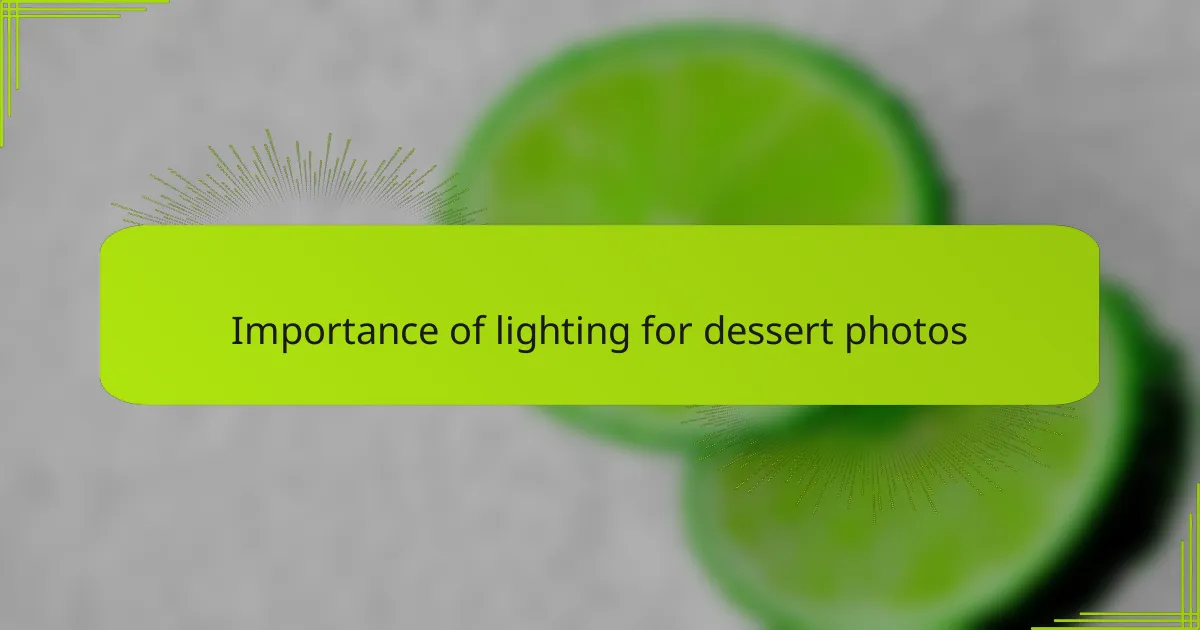
Importance of lighting for dessert photos
Lighting is everything when it comes to making desserts look as good on camera as they do on a plate. Have you ever taken a photo where the frosting seemed dull or the berries looked flat? I’ve been there, and it’s often because the lighting wasn’t highlighting the dessert’s best features. Good lighting breathes life into the image, making textures pop and colors sing.
I remember photographing a lemon tart on a cloudy day and struggling to capture its vibrant yellow glow. Once I shifted the light slightly, the citrusy brightness practically jumped out of the frame. That moment taught me how crucial light’s direction and quality are—not just for visibility but to evoke an appetite in the viewer. Lighting isn’t just a tool; it’s the dessert’s spotlight.
Isn’t it fascinating how subtle changes in light can change the entire mood of a photo? Soft light can make a mousse look luxurious and smooth, while a hint of shadow adds mystery to a rich chocolate cake. From my experience, mastering this balance is what turns a simple snapshot into a mouthwatering story everyone wants to taste.
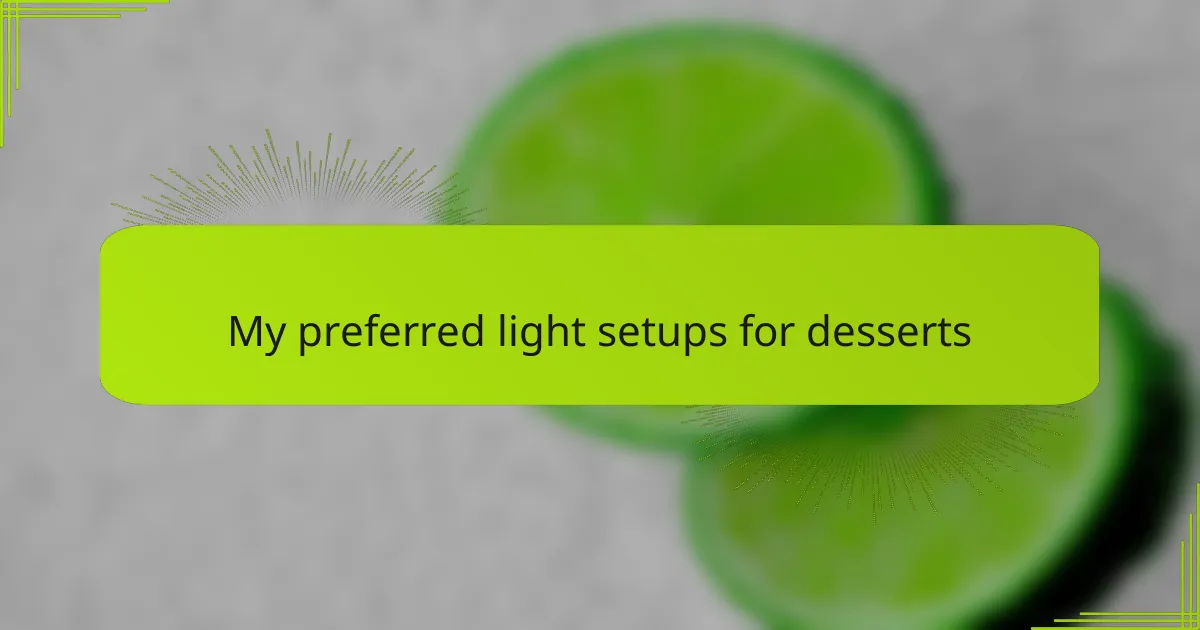
My preferred light setups for desserts
When it comes to my favorite light setups for desserts, natural window light always tops the list. There’s something about the gentle, diffused glow that makes cakes and pastries look inviting without overpowering their delicate details. I recall photographing a batch of cream-filled éclairs bathed in late afternoon sun—each golden puff seemed to glow from within, making me almost reluctant to pick one up and eat it.
I also love experimenting with side lighting to bring out textures. Have you ever noticed how a simple shift in the angle of light suddenly reveals the flaky layers of a croissant or the glossy sheen on a fruit tart? That subtle shadow play adds depth and life, turning an ordinary dessert into a story worth savoring. From my experience, this kind of directional lighting feels like adding a sprinkle of magic to the frame.
On some occasions, I rely on soft artificial light when natural options aren’t available. Using a small diffuser or a white reflector softens harsh bulbs and mimics the warmth of natural light. It’s a little trick that makes chocolate ganache shine without glare or harsh spots—because for me, lighting isn’t just about visibility; it’s about capturing the essence of indulgence that every dessert deserves.
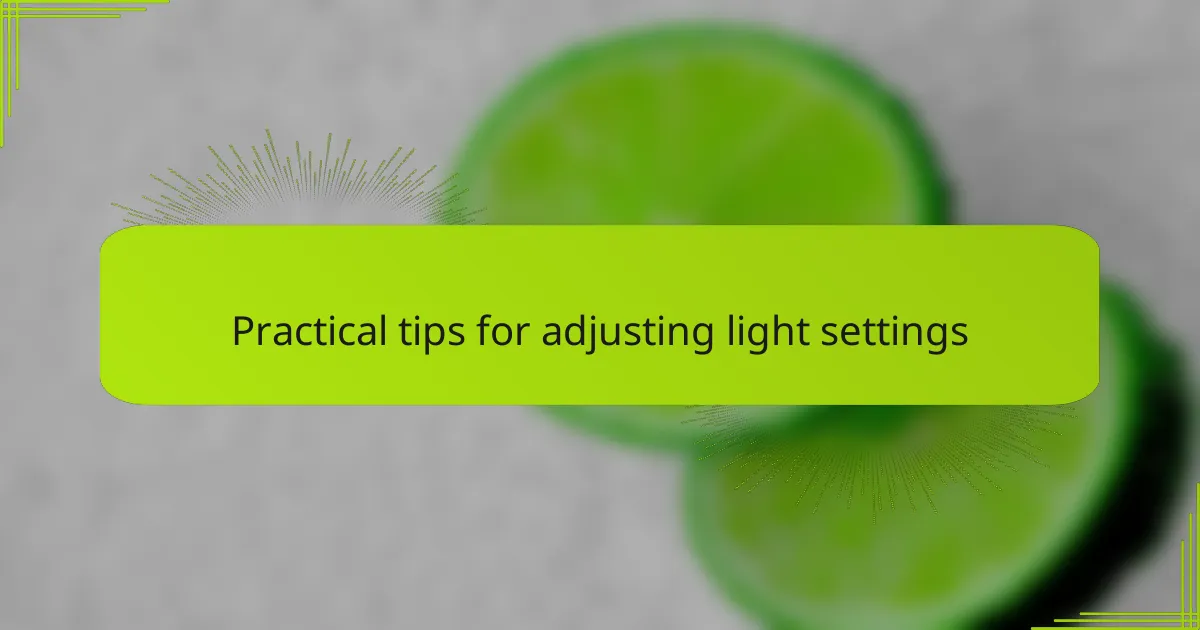
Practical tips for adjusting light settings
Adjusting light settings often feels like a delicate dance to me. I usually start by tweaking the brightness—not too harsh, not too dim—until the dessert looks as if it’s inviting me to take a bite right off the screen. Have you tried moving your light source just a few inches? That subtle shift can suddenly make the texture pop or soften shadows in the most flattering way.
One simple tip I’ve found incredibly useful is to use a reflector or even a plain white card to bounce light back onto the dessert. It’s surprising how this small adjustment can fill in unwanted shadows without killing the natural mood. I remember a shoot where a quick fix with a piece of paper transformed a flat-looking cake into a luscious, dimensional treat that practically begged for a second glance.
Finally, never underestimate the power of experimenting with angles. Sometimes, shooting with the light coming from behind the dessert—backlighting—creates this dreamy glow that feels almost magical. Other times, side lighting reveals every crumb and glossy frosting detail. I keep playing with these angles until the dessert’s personality shines through exactly how I want it to. Have you noticed how changing just the angle can tell a completely different story?
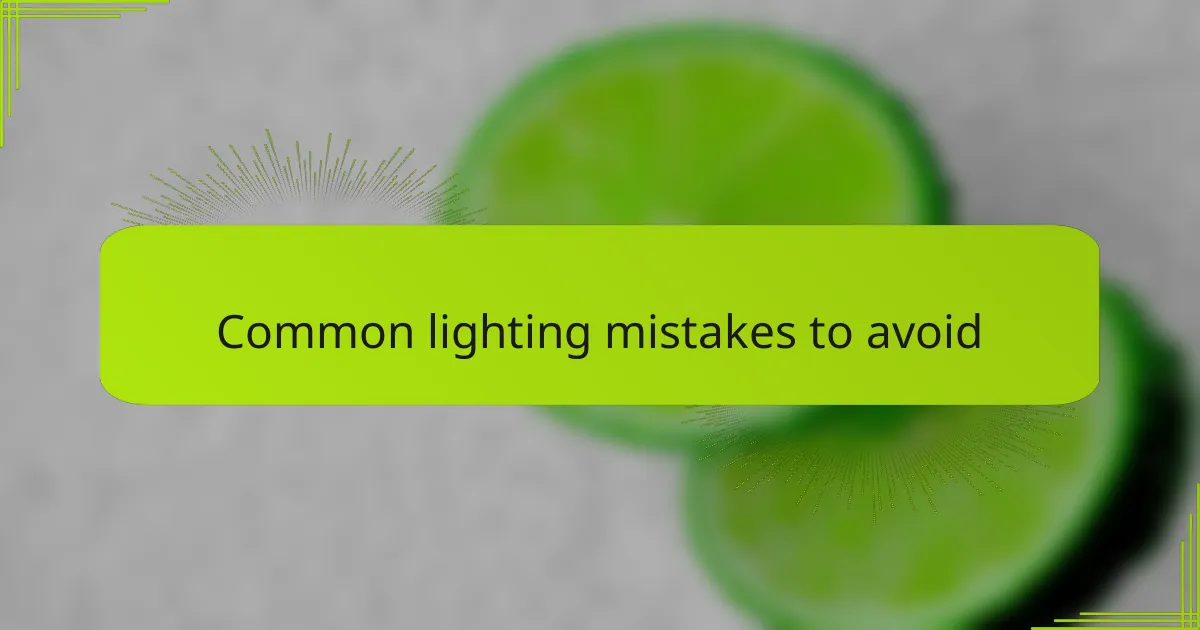
Common lighting mistakes to avoid
One mistake I see too often is relying on harsh, direct lighting that washes out the dessert’s natural textures. Have you ever snapped a photo where the frosting looks almost glossy but lifeless? That usually happens when the light is too strong and unfiltered, flattening the whole image. Early on, I learned that softening light—even with something as simple as a sheer curtain—makes such a difference in preserving the dessert’s appeal.
Another trap I’ve fallen into myself is ignoring unwanted shadows. Shadows can add dimension if placed thoughtfully, but random, harsh shadows can distract and confuse the eye. I remember shooting a layered cake only to find a deep shadow cutting across the plate awkwardly. It disrupted the visual flow, and I had to reposition the light several times before the image felt balanced and inviting again.
Lastly, failing to consider color temperature can seriously harm dessert photos. Ever noticed how some images look cold or unnatural? That’s usually because the light’s color isn’t matching the dessert’s mood. One time, I shot a chocolate tart under a bright, bluish LED and the richness just vanished. Switching to a warmer light instantly restored that cozy, indulgent vibe I wanted to convey. It taught me that understanding and controlling light color is just as important as its direction and softness.
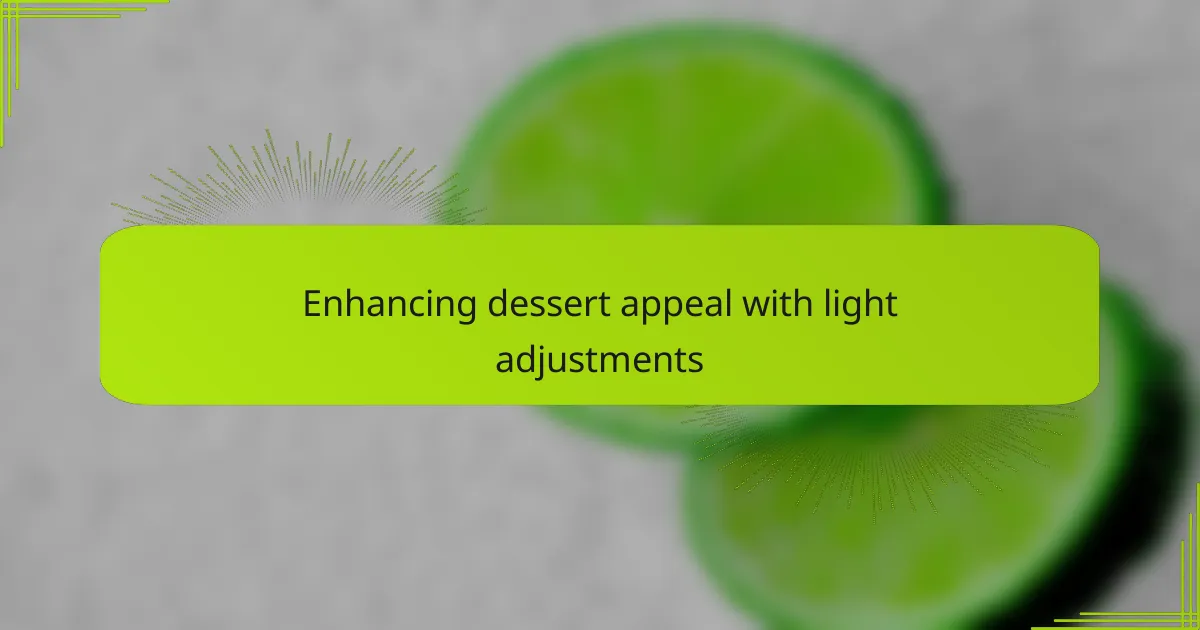
Enhancing dessert appeal with light adjustments
There’s something almost magical about how tweaking light can make a dessert practically beg to be tasted. When I slightly soften the light, the glaze on a chocolate ganache seems to shimmer just enough to draw you in, like it’s whispering, “Take a bite.” Have you ever noticed how subtle light shifts reveal those tiny sugar crystals on a tart, turning something ordinary into an irresistible masterpiece?
I’ve found that adjusting light direction can truly transform the story a dessert tells. For example, side lighting became my go-to after I saw how it enhanced the texture of a flaky croissant, shadows dancing just right to showcase every layer. It’s fascinating how the interplay of light and shadow can add depth, making a flat photo burst with life and flavor.
Sometimes, I ask myself: am I highlighting the dessert’s best angles? Playing with light intensity helps me answer that. Too harsh, and the frosting loses its softness; too dim, and the colors fade. Finding that perfect glow—like the warm afternoon sun on a delicate éclair—is what elevates food photos from snapshots to mouthwatering moments worth savoring.
